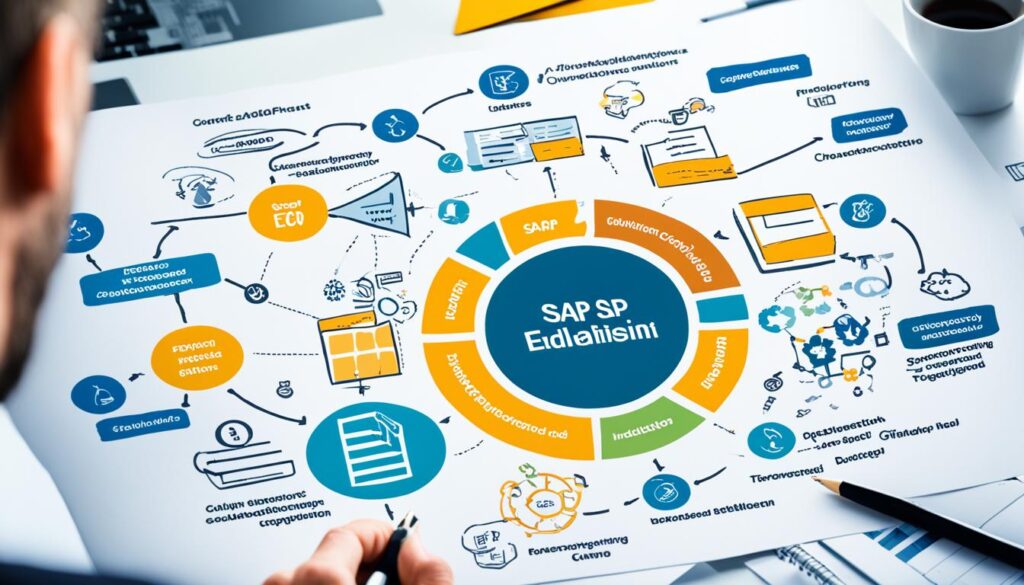This article will dive into SAP (Systems, Applications, and Products) and its key programming language, ABAP (Advanced Business Application Programming). SAP leads in providing enterprise resource planning (ERP) software for many industries. ABAP is crucial for SAP development, helping businesses customize and enhance their SAP systems. By the end, you’ll know a lot about SAP ERP and ABAP’s role in business solutions.
Key Takeaways
- SAP is a top provider of ERP software for various industries.
- ABAP is the language for customizing SAP systems.
- ABAP is vital for SAP development, making solutions fit specific business needs.
- This article will give a full view of SAP ERP and ABAP’s role in business solutions.
- Readers will understand SAP ERP’s capabilities and ABAP’s importance in SAP development.
What is SAP ERP?
SAP ERP (Enterprise Resource Planning) is a top-notch software solution for businesses. It helps streamline and link together an organization’s main business processes. With SAP ERP, companies can make better decisions and work more efficiently.
Understanding SAP’s Enterprise Resource Planning
SAP ERP is a key platform that puts all an organization’s data and resources in one place. This makes it easier to work together across different areas. It helps businesses see the big picture, leading to smarter decisions and better performance.
Key Benefits of SAP ERP Systems
- Increased productivity and efficiency through process optimization
- Enhanced data integration and accessibility for better decision-making
- Improved reporting and analytical capabilities for data-driven insights
- Streamlined customer service and enhanced satisfaction
Using SAP ERP brings many benefits to businesses. It helps them succeed and stay competitive in the market.
SAP System Architecture and Components
To understand SAP’s power, it’s key to know its sap system architecture and main sap components. This solution is built on a strong, growing framework. It brings together different modules for top business efficiency.
The SAP Graphical User Interface (SAP GUI) is at the system’s core. It lets users work with the system easily. Employees can use it for many business tasks, like financial reports and managing the supply chain.
The SAP application server works alongside the SAP GUI. It’s a strong engine that manages the system’s parts. It handles user requests, runs business logic, and keeps data moving smoothly in the company.
The SAP database is the system’s foundation. It’s safe and dependable, holding all the important data for the business. This database supports real-time data access, reporting, and making decisions.
SAP also has many special modules and add-ons. These can be added to the main system. They make the system work better and meet the needs of different industries and business areas.
| SAP System Component | Description |
|---|---|
| SAP GUI | The graphical user interface that provides the primary access point for users to interact with the SAP system. |
| SAP Application Server | The server responsible for processing user requests, executing business logic, and coordinating the various components of the SAP system. |
| SAP Database | The secure and reliable database that stores all the critical data required for the organization’s operations. |
| SAP Modules and Add-ons | Specialized components that can be integrated into the core SAP system to expand its functionality and cater to specific business requirements. |
Knowing the sap system architecture and its sap components helps businesses use SAP fully. This leads to better operations, smarter decisions, and growth in a changing business world.
Introduction to ABAP
ABAP stands for Advanced Business Application Programming. It’s the main language used in the SAP world. This language lets developers customize and add to SAP systems. It meets the specific needs of businesses.
ABAP as a Programming Language
ABAP is a strong and flexible language made for SAP applications. It has many tools and features. These help developers make solutions that work well with the SAP ERP system.
Learning ABAP lets developers use SAP fully. This gives businesses the chance to improve their ERP systems.
Importance of ABAP in SAP Development
- ABAP is key for SAP development. It helps businesses make and keep custom apps in the SAP world.
- With ABAP, developers can make reports, interfaces, and extensions for their organization. This makes things more efficient and competitive.
- ABAP’s object-oriented programming lets developers make solutions that grow with the business. These solutions are easy to keep up and can change as needed.
- Knowing ABAP is very valuable in the SAP job market. It’s a must-have skill for SAP developers and consultants.
Learning ABAP is vital for any business using SAP’s big solutions. By getting good at ABAP programming and ABAP development, teams can make solutions that help the business succeed.
Setting Up Your SAP Development Environment
To unlock the full potential of ABAP, you need a strong SAP development environment. This means installing SAP software and setting up your tools. It ensures a smooth workflow for making innovative solutions.
Your SAP development environment starts with the SAP NetWeaver Application Server. It’s the runtime platform for your ABAP apps. You also need the SAP GUI, a powerful tool for interacting with the SAP system and writing code.
For a better SAP development environment, think about using the SAP Web IDE. It’s a cloud-based IDE that makes coding easier and more collaborative. With it, you get the latest SAP development tools and features like version control and deployment automation.
| SAP Development Environment Components | Description |
|---|---|
| SAP NetWeaver Application Server | The foundation of your SAP development environment, providing the runtime platform for ABAP applications. |
| SAP GUI (Graphical User Interface) | A powerful tool for interacting with the SAP system and writing ABAP code. |
| SAP Web IDE | A cloud-based integrated development environment (IDE) that offers a streamlined and collaborative coding experience. |
With a strong SAP development environment, you’re ready to start your ABAP journey. You can create solutions that help businesses succeed.
ABAP Syntax and Basic Constructs
ABAP (Advanced Business Application Programming) is a powerful language with its own syntax and basic elements. We’ll explore the core parts of ABAP, like data types, variables, control structures, and loops. Understanding these basics will help you create strong and growing applications for the SAP world.
Data Types and Variables
ABAP has many data types for different needs in business apps. You can use integers, floating-point numbers, character strings, and date/time values. It also lets you use variables to store and change data, making your programs more dynamic.
Control Structures and Loops
Developers use control structures and loops to make ABAP programs logical and flowing. ABAP has IF-THEN-ELSE statements and CASE statements for conditional code. Loops like DO-ENDDO and WHILE-ENDWHILE help with repeating tasks efficiently.
Learning the ABAP syntax, data types, and control will set you up for making strong, growing apps in the SAP world.
Introduction to SAP and ABAP
We’ll give you a full introduction to SAP and ABAP here. SAP stands for Systems, Applications, and Products in Data Processing. It’s a top company that makes software for businesses. ABAP, or Advanced Business Application Programming, is the main language for making SAP systems work better for companies.
SAP started in 1972 with five former IBM workers in Germany. Over time, it grew to be a world leader in business software. It helps many industries, like making things, finance, retail, and healthcare. The SAP ERP system is a key product that helps companies run better, work more efficiently, and innovate.
ABAP is a strong programming language linked with SAP. It was made by SAP in the 1980s. ABAP lets developers make new apps, automate tasks, and connect SAP with other systems. It’s a key skill for those who work on SAP to make it better for businesses.
Learning about SAP and ABAP shows how important they are in business software. They help companies improve and stay ahead in the market.
| Feature | SAP ERP | ABAP |
|---|---|---|
| Purpose | Enterprise resource planning (ERP) software | Programming language for customizing and extending SAP systems |
| Functionality | Integrated management of core business processes, including finance, human resources, logistics, and manufacturing | Developing custom applications, automating business processes, and integrating SAP systems with other enterprise systems |
| Adoption | Used by thousands of organizations worldwide | Widely used by SAP developers and consultants |

Working with SAP Data
Working with sap data is key in ABAP development. You’ll learn how to use sap database tables and do abap data manipulation. This section covers how to add, read, update, and delete data. It also talks about complex data tasks.
Database Tables and Data Manipulation
SAP’s ERP system uses a big database for business data. As an ABAP developer, knowing how to work with sap database tables is crucial. You’ll need to understand their structure and how they connect. Plus, you’ll learn abap data manipulation techniques.
Key skills you’ll develop include:
- Using SELECT statements to query database tables
- Inserting, updating, and deleting data with INSERT, UPDATE, and DELETE statements
- Joining tables to get complex data sets
- Sorting, filtering, and aggregating data with ABAP’s functions
- Handling transactions and keeping data consistent
With these sap data skills, you can make strong and efficient ABAP apps. They’ll work well with SAP’s backend systems.
| SAP Database Table | Description | Key Fields |
|---|---|---|
| CUSTOMER | Stores customer info like contact details, sales history, and credit status. | CUSTOMER_ID, COMPANY_NAME, EMAIL |
| SALES_ORDER | Keeps track of sales orders, including details, shipping info, and payment status. | ORDER_ID, CUSTOMER_ID, ORDER_DATE, TOTAL_AMOUNT |
| INVENTORY | Shows the stock levels and locations of products and materials. | PRODUCT_ID, QUANTITY, WAREHOUSE_ID |
Mastering sap data and sap database tables makes you a skilled ABAP developer. You’ll be able to build powerful SAP applications.
ABAP Object-Oriented Programming
SAP uses object-oriented programming (OOP) in its ABAP language. ABAP lets developers write code that’s easy to update and use. It does this by using abap oop and object-oriented programming in abap.
We’ll look at the basics of ABAP OOP here. This includes classes, methods, inheritance, and encapsulation. Knowing these will help you make SAP apps that grow with your business.
Classes and Methods
Classes are key in object-oriented programming in abap. They help make objects that hold data and do things. Each class has methods that do actions and work with the data.
Inheritance and Polymorphism
Abap oop also has inheritance and polymorphism. Inheritance lets you make new classes from old ones, sharing their traits. Polymorphism lets different objects act like one type, making code more flexible and reusable.
Encapsulation and Data Abstraction
Encapsulation is a big part of object-oriented programming in abap. It keeps an object’s inner workings private, making sure data stays safe and organized. ABAP’s data abstraction helps by letting you set up public ways to interact with an object, without showing how it works.
Learning abap oop helps you make SAP apps that are easy to keep up with and efficient. As you keep learning ABAP, knowing about object-oriented programming will be very useful for your SAP projects.
Debugging and Error Handling in ABAP
As SAP developers, we know how crucial it is to make our ABAP applications reliable and efficient. Debugging and error handling are key to this. We’ll look at the tools and methods for debugging ABAP code and best practices for solving problems.
Leveraging SAP’s Debugging Features
SAP has powerful tools for debugging that let us go through our ABAP code, check variables, and find errors or performance issues. The ABAP Debugger is one tool that lets us set breakpoints, step through code, and see how it runs. Knowing how to use these tools helps us quickly fix abap debugging issues, making sure our apps work right.
Understanding Common Error Types
In ABAP development, we often run into different errors like syntax mistakes or runtime exceptions. Knowing about common abap error handling issues, like data type errors or division by zero, helps us stop and fix them. This knowledge lets us use strong error-handling methods to keep our ABAP apps stable and fast.
Implementing Best Practices for Debugging
- Regularly check and test your code to find and fix problems early.
- Use SAP’s debugging tools, like the ABAP Debugger and ABAP Runtime Analysis, to find where issues come from.
- Make a detailed set of test cases to make sure your ABAP code works under different situations.
- Use strong abap best practices for error handling, like structured exception handling and detailed logging.
- Keep up with the latest ABAP programming best practices and techniques to get better at debugging.
By using the debugging tools and error-handling strategies talked about here, we can make reliable and fast ABAP applications for our SAP customers.
SAP Modules and Functional Areas
Understanding SAP ERP systems is complex. It involves knowing its modules and functional areas. SAP is a top enterprise software with tools for modern businesses. We’ll look at the main SAP modules and how they work together. This creates a strong ERP system.
SAP’s core has key modules for different business areas. These include:
- Finance (FI) – Deals with financial accounting, controlling, and treasury management.
- Human Resources (HR) – Covers employee processes like payroll, personnel, and training.
- Logistics (MM, SD, PP, QM, PM) – Includes materials management, sales, production planning, quality management, and plant maintenance.
- Customer Relationship Management (CRM) – Helps with customer activities, including sales, marketing, and service.
- Supply Chain Management (SCM) – Improves the flow of materials, information, and finances in the supply chain.
These SAP functional areas work together for better integration, data visibility, and efficiency. By matching your ABAP work with these modules, your solutions will fit your business needs.
| SAP Module | Key Functionality |
|---|---|
| Finance (FI) | Financial accounting, controlling, treasury management |
| Human Resources (HR) | Personnel administration, payroll, training |
| Logistics (MM, SD, PP, QM, PM) | Materials management, sales and distribution, production planning, quality management, plant maintenance |
| Customer Relationship Management (CRM) | Sales, marketing, service |
| Supply Chain Management (SCM) | Supply chain optimization, materials and information flow |
Integrating ABAP with Other Technologies
ABAP is mainly used in the SAP world, but sometimes, we need to connect SAP with other tech and platforms. We’ll look at how to link ABAP with other systems. This includes using web services and APIs.
Leveraging ABAP’s Connectivity Features
ABAP has strong tools that help developers share data, manage processes, and link business workflows across different systems. These tools make it easy to connect SAP with other apps and services. This way, organizations can use the full power of ABAP integration.
Integrating ABAP with Web Services
Using web services is a key way to connect ABAP with other tech. ABAP supports protocols like SOAP and REST. This lets developers share data and functions between SAP and other systems. It makes data exchange and business processes smoother across the company.
Exploring ABAP APIs
ABAP APIs are also important for linking ABAP with other tech. They give developers a way to work with data, run business logic, and automate tasks. By using these APIs, companies can easily connect their SAP systems with many other apps and services. This creates a more connected and teamwork-friendly IT world.
| ABAP Integration Method | Description |
|---|---|
| Web Services | Enables data exchange and process integration using SOAP or REST protocols |
| ABAP APIs | Provides access to SAP data and functionality for seamless integration with external systems |
Best Practices for SAP Development
Exploring SAP and ABAP requires knowing the best practices for success. These strategies help us create SAP solutions that grow with our business. They make sure our SAP projects are top-notch, easy to keep up, and can handle more work.
Keeping our code tidy is key in sap development. It makes our ABAP programs easy to read and work on together. We should use the same naming rules, break our code into smaller parts, and handle exceptions well.
Improving how fast our code runs is vital in abap best practices. We need to process data efficiently, cut down on database checks, and use ABAP’s tools to speed things up. This makes our SAP systems quick and able to grow, giving users a smooth experience.
Keeping our SAP safe is a top priority. We must use strong access controls, check data before it goes in, and encrypt data to protect it. Doing regular security checks and writing code safely keeps our SAP safe from threats.
Good project management is key to SAP success. We need clear goals, realistic deadlines, and good ways to talk to each other. Using agile methods and working together helps us handle SAP’s challenges better and be more flexible.

By following these best practices for sap development and abap best practices, we can make the most of SAP. Let’s keep improving and aim to be experts in SAP development.
Conclusion
In this article, we’ve looked into the world of SAP and ABAP. We showed how these technologies can change the way businesses work. We covered the SAP ERP system and its main parts, and we learned the basics of ABAP programming.
Now, you know how ABAP can make your SAP systems better. This means you can make your business run smoother, work better, and succeed more. Using ABAP, you can make the most of your SAP setup. This helps your business stay ahead in today’s fast-changing world.
The key takeaways from this article are clear. Mastering SAP’s ERP solutions is key. ABAP is vital for SAP development. With these skills, you can handle the complex SAP world. You’ll be ready to bring big changes that help your business grow and succeed.



0 Comments on “Introduction to SAP and ABAP: Enterprise Solutions”